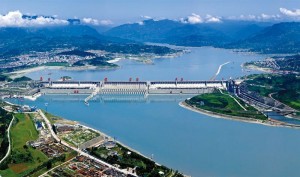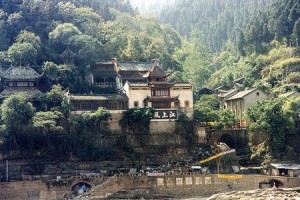The Three Gorges Dam along the Yangtze River in China’s Hubei Province is the largest hydroelectric project every constructed. Begun in 1994 and completed in 2009, the dam is a source of hydroelectric power, shipping locks, and flood control for the middle and lower Yangtze River. However, there were quite a few drawbacks of a project flooding an area of more than 600 square kilometers. As water levels rose, nearly 1.3 million people were forced to relocate. The effects of this displacement were devastating to the population and many Chines cultural sites and artifacts, as the places they had to leave behind have some of the oldest history in China.

The Three Gorges Dam is the largest hydroelectric project ever constructed, and flooded 632 square kilometers of land beyond the existing banks of the Yangtze River.
Some of the above ground historic sites that were below the final water level have had to be preserved on site or moved. The Baiheliang Stone, the best preserved ancient hydrologic station in the world, has been saved through constructing an underwater museum around it. Shibaozhai, an ancient Buddhist temple built by the Ming emperor Wan Li, is now an island in the center of the new lake, surrounded by a concrete dike. Some structures are being moved altogether, such as Zheng Fei Temple, which was moved one brick at a time and reassembled at a higher elevation. However, much of the above ground archaeology is only left in data collected, as the sites themselves have disappeared beneath the water.
The Three Gorges region is the birthplace of Chinese civilization, but archaeology in the region has traced human habitation of the gorges back to the Paleolithic. In preparation for it to be submerged, over 1000 Chinese archaeologists descended on the region to do what preservation could be done in this culturally rich region before the water covered everything. Budgeting problems hindered efforts both with lack of funds and complications with distribution, but archaeologists have still investigated some 1087 sites throughout the valley, gaining information about habitation of the region as early as 2 million years ago, as well as for nearly every era of habitation since. However, countless more data has been lost to the rising water levels.
Looting, too, has been an enormous problem for the archaeological record as both professional scavengers and local farmers descended on sites throughout the gorge. Many of the sites found in the region were left without surveillance before they were able to be excavated or were submerged. Over the course of dam building, many artifacts from the Three Gorges area went up for sale through dubious channels, most notably a bronze spirit tree dating to the Han dynasty. Though these pieces have been saved from submersion, their context has been destroyed, causing the loss of valuable archaeological data.
Sources
http://digital.csic.es/bitstream/10261/27902/1/Lopez-Pujol_01.pdf
http://news.xinhuanet.com/english2010/culture/2010-11/29/c_13627200.htm
http://gadling.com/2010/11/29/archaeological-treasure-trove-found-at-three-gorges-project-in-c/
http://articles.latimes.com/2003/jun/08/opinion/oe-see8
http://archive.archaeology.org/9611/abstracts/3gorges.html
http://www.npr.org/templates/story/story.php?storyId=17810431
http://archive.archaeology.org/online/news/china.html
http://www.china.org.cn/english/features/Archaeology/96925.htm
http://news.cision.com/se/ifs/i/three-gorges-dam-small,c1262559
Further Reading
More about the Ba people, who flourished in the Three Gorges area until the Warring States Period
http://www.chinaculture.org/gb/en_curiosity/2004-02/11/content_45954.htm
More about history and legend in writing about the Three Gorges region

